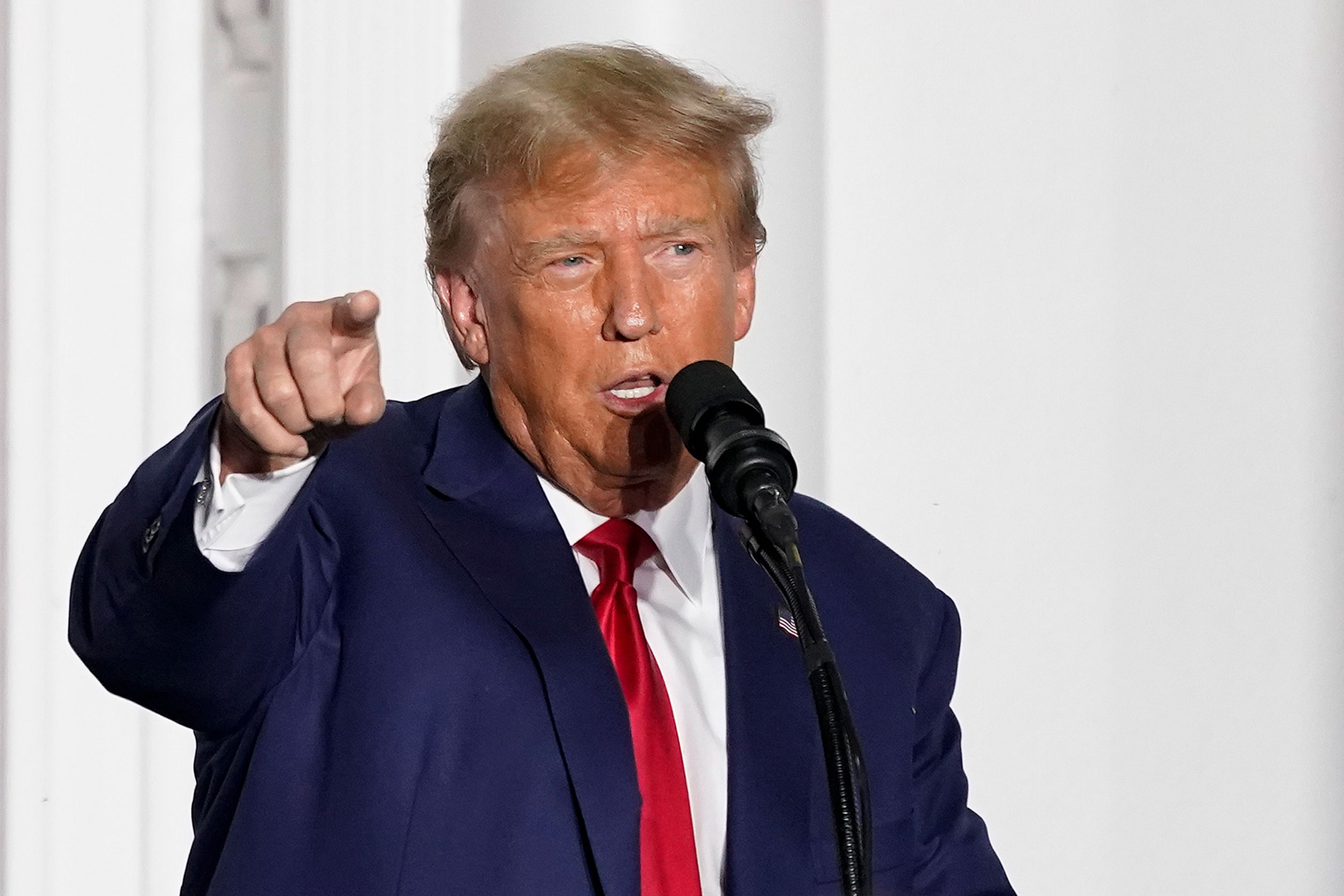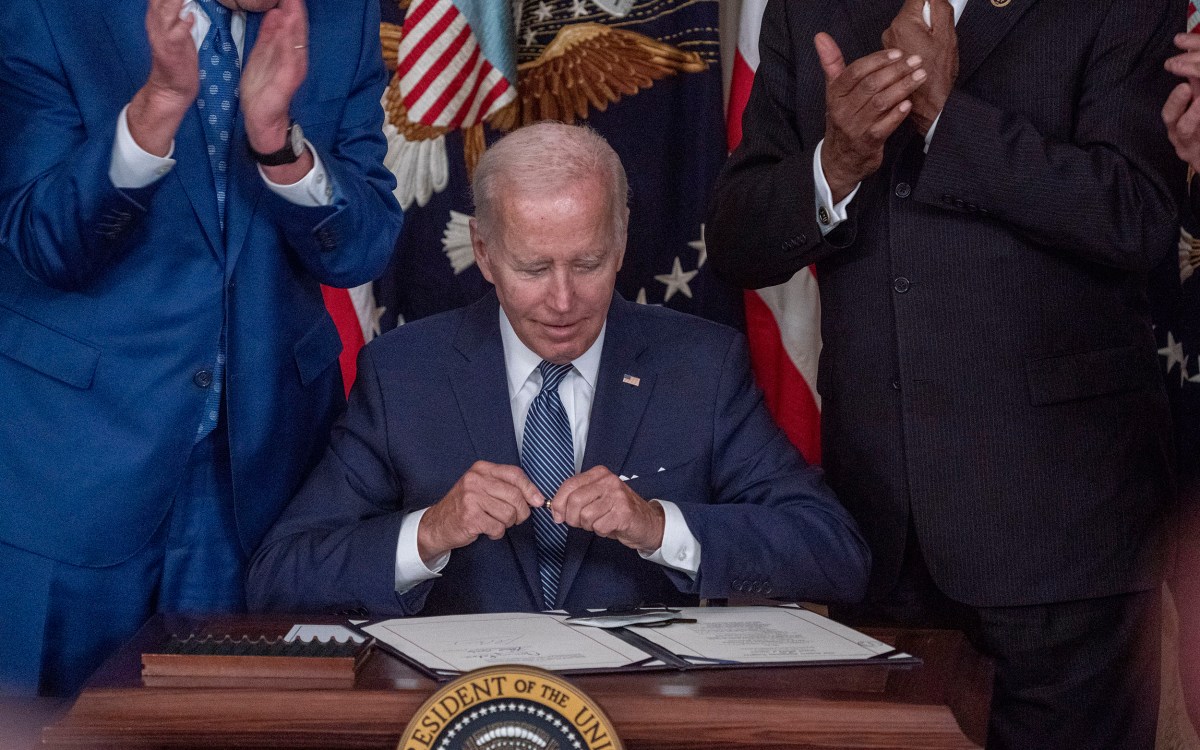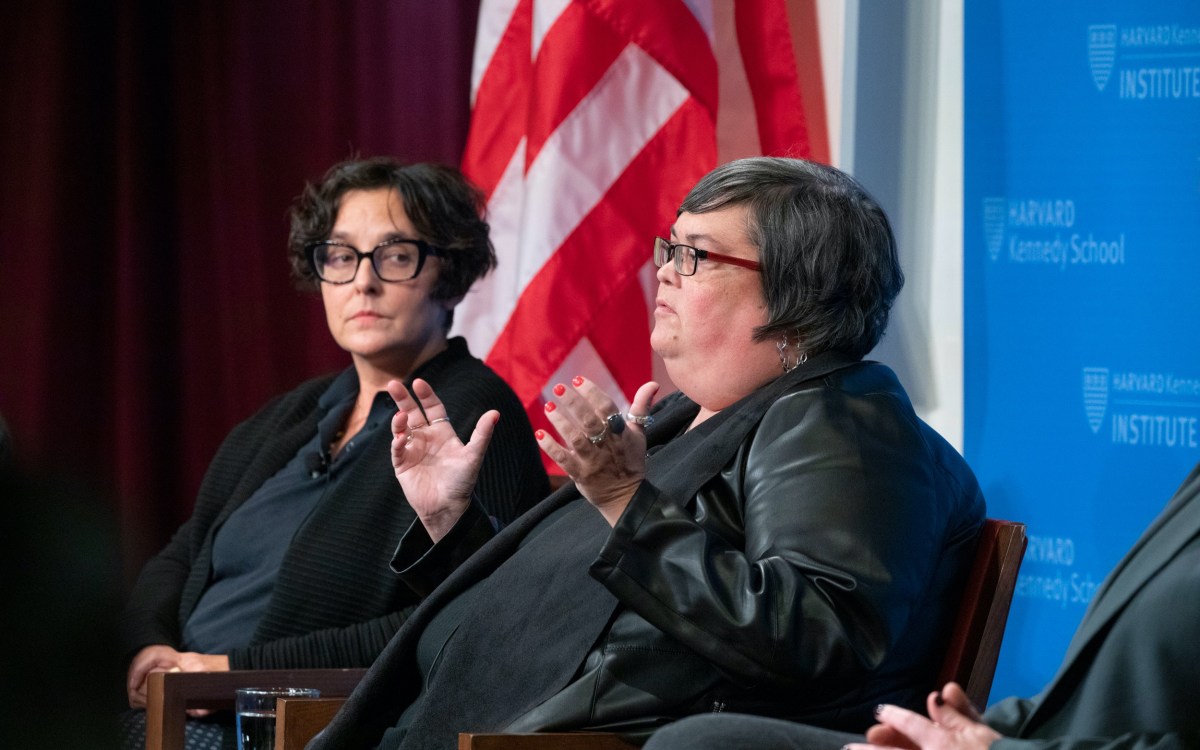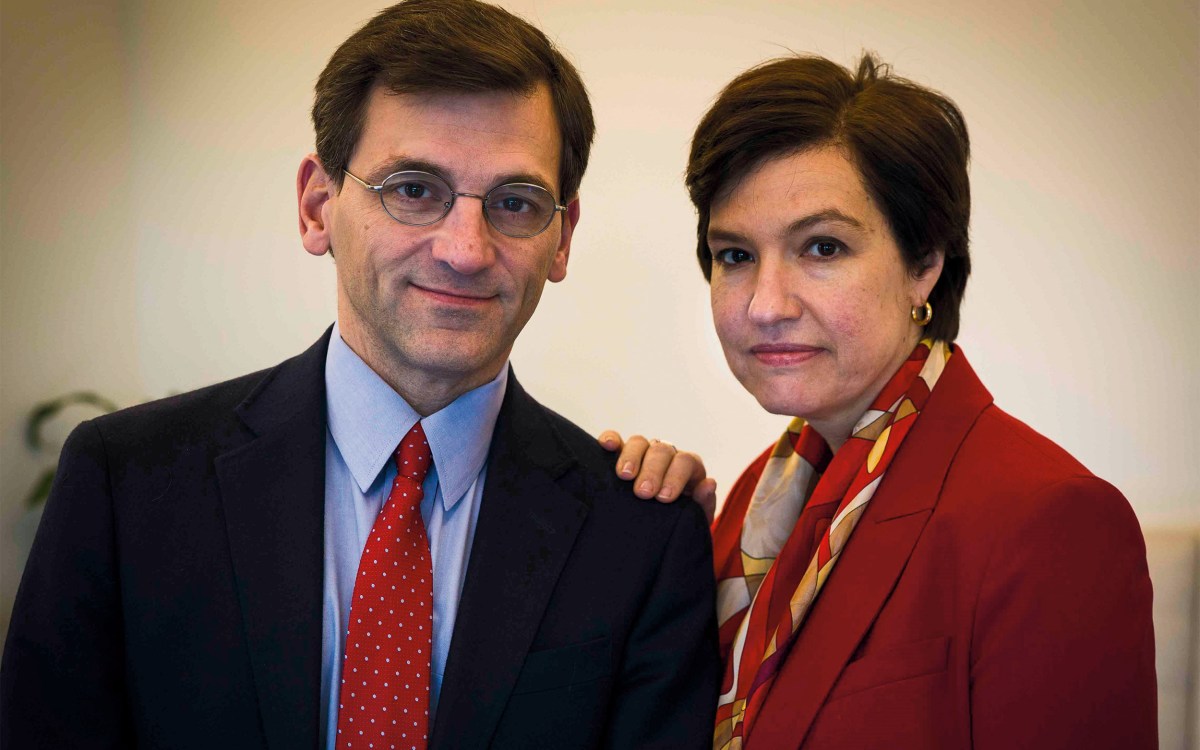
Former President Donald Trump speaking to supporters last week in New Jersey.
Mary Altaffer/AP Photo
Muting Trump’s ‘megaphone’ easier said than done
Political experts suggest ways media can blunt former president’s skillful manipulation of coverage to spread falsehoods, divisiveness
How do you cover Donald Trump?
He’s going to do a lot of speeches, and parts of his message will be provably false, reflect intolerance, and promote anti-democratic ideas. Reporters can’t simply ignore him because he is an important public figure but quoting him potentially makes them complicit in spreading falsehoods that are often sharply divisive and periodically dangerous.
Harvard media experts say that after two presidential campaigns — with a third starting — and four years in the White House, the nation’s media outlets still don’t seem to know how best to cover the former president, and the nation is poorer because of it.
“There’s still this set of norms for how journalists do things that has been taught since the founding of journalism schools, and they’re just not able to deal with a case like Trump,” said Matthew Baum, the Marvin Kalb Professor of Global Communications at the Harvard Kennedy School. “They’ve just fallen down.”
If anything, Trump has signaled that he’s doubling down on his unique combination of bravado, brazenness, and selective adherence to the truth that he rode to power in 2016. Through two presidential impeachments and now two post-presidential indictments, he seems to embody the old political saw: “I don’t care what you say, just spell my name right.”
Trump has cast congressional, civil, and criminal investigations as political “witch hunts” with no substance, a framing many of his supporters accept. Indeed, instead of being chagrined, he’s taken them as opportunities to raise funds and heighten his media profile.
The impact of his legal woes on Republican primary voters was illustrated by a June 14 Quinnipiac University poll showing that, after being indicted for mishandling classified documents, he remains the front-runner for the 2024 Republican presidential nomination, 30 points ahead of Florida Gov. Ron DeSantis, who is in second place.
A CNN town hall last month, moderated by Kaitlan Collins, illustrated the media’s problem. The crowd, made up largely of supporters, felt more like a campaign rally than an exercise in journalism. There was a standing ovation when the former president walked on stage, hearty applause when he repeated falsehoods, and mocking laughter when Trump characterized writer E. Jean Carroll as a “whack job.” The day before the town hall a jury had found Trump liable for sexually abusing and defaming Carroll and awarded her $5 million in damages.
The hour provided Trump the chance to detail debunked claims of election fraud, characterize migrants seeking entry to the U.S. as former prison inmates and patients from mental institutions, and falsely insist former Vice President Mike Pence had it within his power to send the 2020 election back to the states on Jan. 6, 2021, the day of the Capitol riot.
The network was heavily criticized for providing Trump a forum to repeat statements that had been proven to be untrue. The event reportedly contributed to the ouster of CNN chair Chris Licht.
“I haven’t seen a good content analysis of the last year, but I bet he’s coming close to as much coverage as the president has received, That’s really unusual. And that isn’t just about newsworthiness; it’s also about ratings.”
Thomas Patterson, the Bradlee Professor of Government and the Press at HKS.
The Trump problem is at least as old as his 2016 presidential campaign, when coverage of him exceeded that of other candidates, with the effect of amplifying his message. On CNN alone, the phrases “crooked Hillary” and “lock her up” were repeated 3,000 times during the campaign, according to Thomas Patterson, the Bradlee Professor of Government and the Press at HKS.
“Nobody watches CNN 24 hours a day, but the steady viewer was getting exposed to hundreds of those, and those things sometimes sink in and actually erode trust,” Patterson said.
Even with a different occupant in the White House, the media fixation on Trump has continued, ramping up again recently with the launch of his latest presidential bid, lawsuits in New York and Florida, and his indictments. The end result, Patterson said, is that Trump — today one among several Republican contenders — may be getting sitting-president level coverage.
“I haven’t seen a good content analysis of the last year, but I bet he’s coming close to as much coverage as the president has received,” Patterson said. “That’s really unusual. And that isn’t just about newsworthiness; it’s also about ratings.”
Over time the media has developed a response to Trump’s penchant for eye-popping statements, and that is to highlight inaccuracies that they feel compelled to repeat. But it’s been ineffective, Patterson and Baum agree.
Reporters have become more outspoken in directly pointing out untruths and inaccuracies, shifting from a once-widespread practice in journalism of hunting up an expert or other source to make the characterization. Now, reporters often simply say that a statement isn’t true.
Patterson said that change is in some ways positive because it corrects the record. But it also carries a danger of turning the focus of a story to the reporter, fostering an acceptance of reportorial “me-ism” that has the potential to distort professional judgment.
The second danger, Patterson said, is of ordinary misstatements — natural for anyone who is a regular public speaker — being presented in the same category as intentional, damaging lies, like those of the 2020 election being stolen.
“If you talk a lot, you’re going to make those kinds of mistakes. To draw attention to every one of those tells the audience that you can’t trust anything politicians are saying,” Patterson said. “A certain degree of caution about politics is important, but most of those people aren’t lying, most of those are just inadvertent errors in memory. In Biden’s case, they call it out and put it in the context of his age, and I’m sorry, but we all do it. We did it when we were 30, or 60, or 80. And journalists do it — they have errors in their stories — and no one accuses them of losing their minds or doing it maliciously.”
Similarly, the creation of a separate “fact-check” piece has always been part of the journalistic tool kit, and its use has grown greatly. But Baum said they tend to be ineffective in countering the original statement — and have become increasingly popular with those looking to tar an opponent’s reputation.
“Fact-checking is not a sufficient response,” Baum said. “Journalists don’t have an answer to this question, so they fall back on their routines and norms. But they’re no good here. They don’t work.”
Potential solutions vary depending on the nature of the coverage. For something like a candidate forum, Trump has long proven a master at getting his message out despite efforts by moderators to press him to answer the questions asked and to challenge falsehoods. Ensuring the audience is somewhat impartial will make it less likely the event will resemble a campaign rally or appear as if the network is in a candidate’s corner.
“It was a no-win situation,” Baum said of the CNN town hall. “It’s not that the facilitator, Kaitlan Collins, wasn’t doing a professional job. It’s that it was a hopeless job. It couldn’t be done.”
For that type of event, Patterson said, the work in ensuring that it doesn’t wind up a megaphone for wild statements has to occur behind the scenes in advance by the people negotiating ground rules for format and audience makeup.
With everyday coverage, editors and reporters should understand the ordinary rules don’t apply, Baum and Patterson said. They have to think hard and be more deliberate about whether coverage is warranted, and, if so, ensure it doesn’t amplify false or damaging information.
“We’re playing with fire when we cover Donald Trump like a regular political candidate. He carries with him the kinds of dangers to our politics that we haven’t faced since the 19th century, and that are pretty huge and fundamental,” Baum said. “We shouldn’t just pretend this is a normal campaign — we do our job and put the camera up and let the American people decide — because that’s not how human beings reason. If you assume that people are going to make dispassionate, rational judgments about the veracity of what politicians — who are expert communicators — say as they try to manipulate you, you’re misunderstanding how typical people are likely to respond,”
Patterson said stories about Trump’s tweets are a good example. During his presidency, it was routine that he would tweet something outrageous and the media would cover it, making national headlines. But a study of people who had viewed the tweets showed that 95 percent discovered them through media coverage, not Twitter.
“That’s the stuff to avoid. That’s just playing into his hands. They have to be really careful with Trump about not giving him these free opportunities to go off and do his thing,” Patterson said. “This is a matter of judgment, and I think the judgment has been pretty poor, to be honest, about covering Trump.”
Baum doesn’t expect Trump’s strategy to go away when he does, because his approach works with a significant portion of the electorate.
“Do I need to say more than ‘Ron DeSantis’? He has clearly decided that if he can be a slightly more organized and strategic version of Trump, he can win,” Baum said. “As long as the Republican party is dominated by his base — and Trump has created this base identity — there are going to be entrepreneurs competing to capture it. It’s already on the brink of outliving Trump. We’ll see how things go.”








